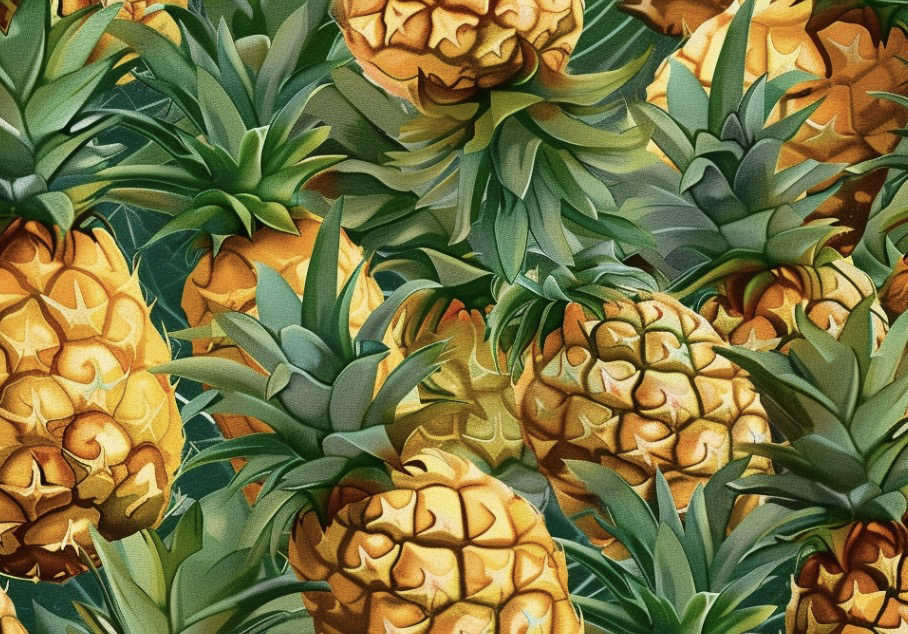The golden age of the Pineapple : a 7,000 dollars fruit
The pineapple, an exotic fruit with a remarkable golden age, was once worth the equivalent of $7,000 - Discover the brief history of the pineapple
The pineapple, an exotic fruit that enjoyed a remarkable golden age, was once worth the equivalent of $7,000. This period not only illustrates the exclusivity and luxury associated with this tropical fruit but also raises fascinating questions about value, trade, and social status throughout history.

Brief History of the Pineapple
The pineapple has traversed the centuries to become one of the most coveted and appreciated fruits around the world. Its origins are lost in the midst of time, within the lush regions of South America. Discovered by Europeans during the great explorations, it became a symbol of wealth and exoticism in Europe. Its rarity made it an exceptional dish, reserved for the tables of the most affluent, hence the extravagant price it could reach at certain times, equivalent to $7,000 today.
- Costly Importation: The pineapple required long and hazardous journeys to reach Europe, hence its high price.
- Greenhouse Cultivation: To meet demand, special greenhouses were built, making its cultivation possible closer to consumers, but still at a high cost.
- Gradual Democratization: With improvements in cultivation techniques and transportation, the pineapple became more accessible, gradually losing its luxury status.
The journey of the pineapple, from its American origin to its massive consumption worldwide, embodying first absolute luxury before becoming a fruit appreciated by all, is a fascinating testimony of the evolution of human societies and their relation with nature.
Why $7,000? A Glimpse of Exclusivity
In the opulent world of rare products, the $7,000 pineapple stands out as a symbol of exclusivity and sumptuousness. This dizzying price tag did not emerge from the void. It is rooted in a combination of factors that make this pineapple not only rare but extraordinarily precious.
- Rarity and Origin: Cultivated in specific climatic and geographical conditions, this pineapple comes from rare lands, making each fruit a work of art by nature.
- Cultivation Techniques: Employing demanding traditional methods and laborious care, each pineapple demands significant investment in time and care, attaching to its price a dimension of ancestral know-how.
- Exceptional Quality: Its flavor, aroma, and texture are incomparable. The fruit is often described as the ultimate pineapple, offering an unmatched taste experience.
- Exclusive Presentation and Packaging: The pineapple is presented in packaging as luxurious as its contents, adding to the prestige and exclusivity of the product.
Thus, the $7,000 price reflects not only the uniqueness and rarity of the pineapple but also the pinnacle of an unforgettable culinary experience, a luxury that few can afford.
Pineapple in Art and Culture
The pineapple, with its exotic silhouette and deliciously sweet taste, has long captivated the imagination of artists and cultures around the world. Symbolizing hospitality and exoticism, the pineapple has emerged in art and culture as a recurring motif, reflecting both the fascination and luxury this fruit represented over the centuries.
In artworks, the pineapple has often been depicted as a symbol of welcome, adorning paintings, sculptures, and even architectural elements. This representation originates from Indigenous American societies, where the pineapple was offered as a sign of hospitality. With the arrival of Europeans and the start of transatlantic trade, this tradition was enriched with a luxurious dimension; the pineapple becoming a prestigious object in elite European circles.
Moreover, the pineapple has become a popular theme within popular culture, shining through in fashion, interior decoration, and even gastronomy. From clothing to wallpapers, the pineapple motif invokes a tropical paradise and a certain elegance. In the culinary field, the pineapple has inspired numerous dishes and drinks, often symbolizing adventure and exoticism.
Through these artistic and cultural expressions, the pineapple is more than just a simple fruit; it has become a global icon that transcends cultural barriers, representing opulence, hospitality, and a certain idea of travel and discovery.
Symbol of Luxury and Status
In the vast universe of art and culture, the pineapple has transcended its status as a mere fruit to become an elaborate representation of luxury and prosperity. Its image, captured with precision and eloquence through various artistic forms, from painting to sculpture, once signaled immense wealth and elevated social status. Here are some notable reasons for this symbolism:
- Rarity and Cost: At a certain time, a pineapple could cost the equivalent of $7,000, making its possession a luxury that few could afford.
- Hospitality and Welcome: Beyond its monetary value, the pineapple was seen as the ultimate gesture of hospitality; offering a pineapple to one's guests thus signified grand honor and a warm welcome.
- Ornamentation: Often, the fruit was rented or bought at a high price merely to be displayed during significant events, adding to the splendor and festivity of celebrations without even being consumed.
The pineapple, in its golden splendor and exotic form, continues to shine as a persistent symbol of luxury and exclusivity in many aspects of contemporary culture and design, keeping alive the fascination for this extraordinary fruit.
The Pineapple in Painting and Sculpture
Throughout history, the pineapple has captured the imagination of artists and sculptors, becoming a recurring motif in various works of art. As a symbol of wealth, exoticism, and hospitality, this fruit has transcended its edible nature to carve a path through the art world.
- Painting: The pineapple has often been depicted in still life paintings of the 17th and 18th centuries, a period during which its rarity made it an attribute of luxury and social status. Artists like Willem Kalf and Jan Davidsz. de Heem immortalized the pineapple, placing it at the heart of rich and detailed compositions that celebrated the abundance and variety of nature's gifts.
- Sculpture: In sculpture, the pineapple elevated to a decorative motif, appearing atop gateposts, furniture friezes, or as the central element in garden fountain designs from various periods. Its unique form and particular texture made it a subject of choice to test the talent and ingenuity of sculptors, especially in the Baroque period.
Thus, the pineapple, beyond its flavor and nutritional qualities, holds a place of honor in art and culture. Symbolizing both a taste for adventure and the pleasure of the senses, it embodies an inexhaustible source of inspiration for artists across the centuries.
Today: Is the Pineapple Still a Luxury?
Once the ultimate symbol of wealth and prestige, the pineapple has traversed a long path towards accessibility. At its time, the echo of its exorbitant price of $7,000 per piece resonated in elite circles, rendering it nearly untouchable for the common folk. However, the question remains: does the pineapple still represent a luxury item today?

In an era where globalization and technological advances have revolutionized agriculture and trade, the pineapple has shed its unaffordable luxury halo. Its ubiquity in supermarkets around the globe contests the notion that it remains a fruit of prestige. More than a simple food item, the pineapple has become a common consumer product, accessible to all or nearly all, marking a profound departure from its sumptuous past.
It's important to note, however, that specific varieties, grown under certain conditions, may still carry a luxury label due to their rarity and demanding cultivation methods. But aside from these exceptional instances, the transformation of the pineapple from a symbol of splendor to an everyday fruit is undeniable. Thus, to the initial inquiry, the answer is clear: no, the pineapple is no longer the unreachable luxury it once was.
The Modern Pineapple Market
The modern pineapple market has evolved significantly from its days of glory when it symbolized the ultimate luxury and exoticism. Today, this fruit has become much more accessible, thanks notably to:
- Improvements in cultivation techniques that allow for mass production and better resilience to climatic hazards.
- Optimization of logistical chains making its transport more efficient and less costly, even for the most sought-after varieties.
- Expansion of its availability on global markets, offering consumers year-round access rather than during specific seasons.
However, this doesn't mean the pineapple's prestige has completely waned. Some rare and sought-after varieties retain a touch of luxury, witnessing their rich history and exceptional taste qualities. The balance between abundance and exclusivity now shapes the modern pineapple market, reflecting a fascinating dynamic between past and present.
The Pineapple: From Exotic to Everyday
Once an undisputed symbol of luxury and exoticism, the pineapple has made a long journey to democratize and become accessible to the general public. This tropical fruit, once a sought-after rarity present at the most sumptuous receptions, has today found its place in kitchens worldwide. This shift in status occurred due to several factors:
- Improvements in transportation techniques have reduced costs and delays, making pineapples available all year round.
- The development of new farming methods has increased production and ensured better quality fruits.
- Globalization of trade has favored a broader distribution and introduced the pineapple to regions where it was previously unknown.
These developments have contributed to transforming the pineapple from exotic to commonplace, making it a fruit enjoyed by all and no longer just a privilege for the elites. Thus, the pineapple has shed its luxury status to become an everyday item, witnessing the socio-economic and cultural changes of our society.
Conclusion
In conclusion, the pineapple, this exotic fruit once perceived as a symbol of luxury and prestige, has traversed the centuries to anchor itself in our gastronomic and cultural history. The era when a pineapple was worth a fortune, sometimes reaching the staggering price of $7,000, reflects a period when rarity, exoticism, and luxury met to make it one of the most coveted commodities in Europe. This fascination for the pineapple was not merely a gustatory whim but a true display of wealth and power. Today, although the pineapple has become much more accessible thanks to agricultural advancements and international exchanges, the echo of its golden age still resonates, reminding us of the importance and the impact of culinary discoveries in the social and cultural evolution of our societies. The pineapple remains a fruit appreciated by all, and its fascinating story continues to fuel our curiosity and admiration for these treasures of nature that, once, were worth more than gold.
The Evolution of the Pineapple's Value
Once, the pineapple stood out as an exotic rarity, its value hovering in a sphere where only the elite could afford the luxury of tasting it. This perception of luxury was not arbitrary; it directly stemmed from its limited accessibility and the challenge of transporting it to European courts. But time and innovation have changed the game. Here are some key elements marking this evolution:
- The refinement of transportation methods: Significant advancements in modes of transport have facilitated the importation of exotic fruits, including the pineapple, making it more accessible.
- Domestic cultivation and hydroponics: The introduction of agricultural techniques allowing the cultivation of pineapple outside its natural habitat has helped regularize its supply.
- The evolution of tastes and consumption patterns: The fruit has gradually lost its status as a luxury symbol to become a common ingredient in global diets.
Thus, from a symbol of opulence and prestige, the pineapple has turned into a beloved fruit for its sweet flavor and increased availability, losing a significant part of its initial perceived luxury value.
The Future of this Iconic Fruit
The pineapple, a symbol of exoticism and luxury, faces a future where its status could radically change. Long perceived as a curiosity with inaccessible prices, it now stands at a crossroads, between democratization and the preservation of its legacy. What lies ahead carries several challenges:
- Sustainability: Intensive agriculture threatens the ecological balance in pineapple cultivation areas. How can increased production be reconciled with respect for nature?
- Accessibility: Facing a rising demand, the challenge is to maintain affordable costs while ensuring fair compensation for producers.
- Authenticity: Preserving ancestral varieties without fully yielding to the siren calls of industrialization will guarantee the pineapple a special place in consumers' hearts.
The future of the pineapple thus lies in a delicate balance between tradition and innovation, a challenge that only commitment and responsibility can overcome to ensure that this fruit maintains its aura while becoming a respectful player in the global agri-food arena.
FAQ: Pineapple
Where does the pineapple come from?
The pineapple originates from South America, primarily from Brazil, Bolivia, and Paraguay. It was domesticated by the indigenous peoples of this region millennia ago for its juicy and sweet fruit.
When was the pineapple introduced to Europe?
The pineapple was introduced to Europe shortly after its discovery by Christopher Columbus on his second voyage to the Americas in 1493. Its rarity and exotic flavor quickly made it a highly prized fruit among European elites.
How is the pineapple cultivated?
The pineapple is cultivated from the crown of the fruit or a plant. It requires a warm climate and good exposure to sunlight. Pineapple cultivation generally takes between 18 and 24 months to produce a mature fruit.
What are the main pineapple producing countries?
The main pineapple producing countries include Thailand, the Philippines, Brazil, and Costa Rica. These countries have ideal climates for pineapple cultivation, allowing for large-scale production.
What are the nutritional benefits of pineapple?
Pineapple is rich in vitamins C and B, minerals such as manganese, and contains a unique enzyme, bromelain, which aids in protein digestion. It is also low in calories, making it attractive for a balanced diet.
How is pineapple used in cooking?
In cooking, pineapple is used in various ways: fresh in desserts, fruit salads, and smoothies; cooked in savory dishes, such as Asian cuisine and on pizzas; or transformed into juice and in some alcoholic beverages.



Poster un commentaire